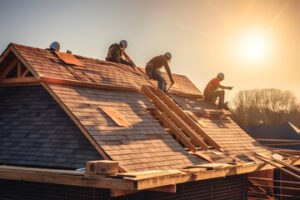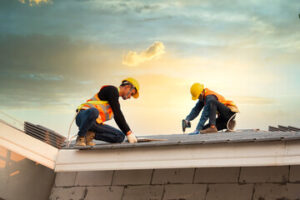When roofing installation begins, the contractor will cover sensitive areas around your house and yard with tarps and wooden boards to protect plants and keep debris from falling. They will also set up a dumpster to dispose of old roofing materials.

A quality roofer will use flashing in leak-prone spots around chimneys, vents and joints. They will also waterproof the valleys, which are where different sections of the roof meet. Contact Missoula Roofing for professional help.
Choosing the right material is important because it will affect the overall cost and durability of your roof. Different materials offer different aesthetics, price points and lifespans. Roofing professionals will help you select the best material for your budget and goals.
The type of material you choose will depend on whether the roof is new construction or replacement. A new roof offers more options in terms of style and design, while a replacement will be limited by the size, pitch and composition of the existing roof structure.
When selecting a roofing material, it is important to consider the climate and weather patterns in your area. For example, if it rains a lot in your area, you might want to choose a waterproof material or one that can be slanted to allow water and snow to slide off the roof easily. In addition, if there is a lot of humidity in your region, you may need to choose a material that can resist mold, mildew and other growths.
Asphalt shingles are the most popular residential roofing material because they are affordable and easy to install. They come in a variety of colors and styles that can complement any home.
Another option is tile roofing, which can add a dramatic look to your home. However, this type of roof is heavier than asphalt shingles and requires more extensive framing to support the weight. Also, it is difficult to repair and replace a tile roof.
Metal panels are another durable roofing option. They are available in a wide variety of shapes and sizes and can be customized to fit any roof. They are also fire resistant and easy to maintain. However, metal panels are more expensive than other roofing materials and require a professional installation.
If you have a flat roof, the contractor will install underlayment and felt paper to protect the insulation boards from moisture. Then, they will begin laying the shingles in rows, starting at the eaves and working up to the peak. The shingles are secured with nails that are closer together near the edge and spread out more towards the center. Flashing is then installed where the roof meets the slopes to prevent leaks.
Nails
Roofing nails are used to fasten shingles and other roof materials. They are available in a variety of lengths and gauges, and are made of different materials to meet the specific needs of each type of roofing project. For instance, roofers often use ring roofing nails that are made of hot-dipped galvanized steel and are 12-gauge or thicker for optimal performance. These nails have wide heads that allow them to grip shingles and other materials securely.
The nail material is important because it affects the overall strength and longevity of the fastener. For example, aluminum nails are commonly used to secure asphalt shingle roofs because they’re inexpensive and easy to purchase. But they’re also prone to corrosion, which makes them less durable than other roofing nail options. On the other hand, stainless steel nails are an excellent choice for damp or humid environments because they’re resistant to rust and corrosion. They are often preferred by roofers for projects involving slate or ceramic tile because they can handle the weight of these heavier tiles.
Additionally, some types of nails are more suitable for securing felt underlayment than others. For example, you want to avoid using smooth shank nails because they lack the holding power needed for roofing. Moreover, the holes left by these nails will allow water to seep through the roof. To prevent this, use roofing nails that have plastic caps for heads instead.
Moreover, it’s a good idea to use roofing nails that are half an inch longer than your typical nails because they can pierce through more layers of shingle. You can also opt for galvanized or stainless steel roofing nails that have a zinc coating. The zinc layer helps to protect against rust and corrosion. Lastly, copper nails are a smart option for slate and copper metal roofs. They naturally resist rust and corrosion and they develop a protective patina over time. These nails are more expensive than galvanized or stainless steel roofing nails, but they’re worth the investment for projects involving copper accents.
Sealing
Before roofing installation begins, your contractor should have multiple protective measures in place. Tarps cover delicate areas like gardens and air conditioning units so that debris falls on them instead of your house, dumpsters are delivered to hold the old material, and wooden boards are used to cover things like patio furniture or a pond to keep them from getting damaged during the tear off process.
The first row of shingles, called a starter strip, is installed with the self-sealing adhesive side facing up along the eave. This creates a strong, waterproof seal that protects the underlayment and shingle tabs from water intrusion.
All roof penetrations are sealed, including the gable vents for sewer ventilation and the curve vents that ventilate bathrooms and kitchen ranges. The roof valleys are also waterproofed with underlayment and felt paper. These are the areas that slope in a “V” shape and get a lot of water running through them.
During this phase, the hammering from the roofers can cause items to fall, so you should remove pictures and decorative items hanging on walls and ceilings. You should also turn off any alarm systems that are located inside your home, as the movement and vibration from the hammers can activate them.
